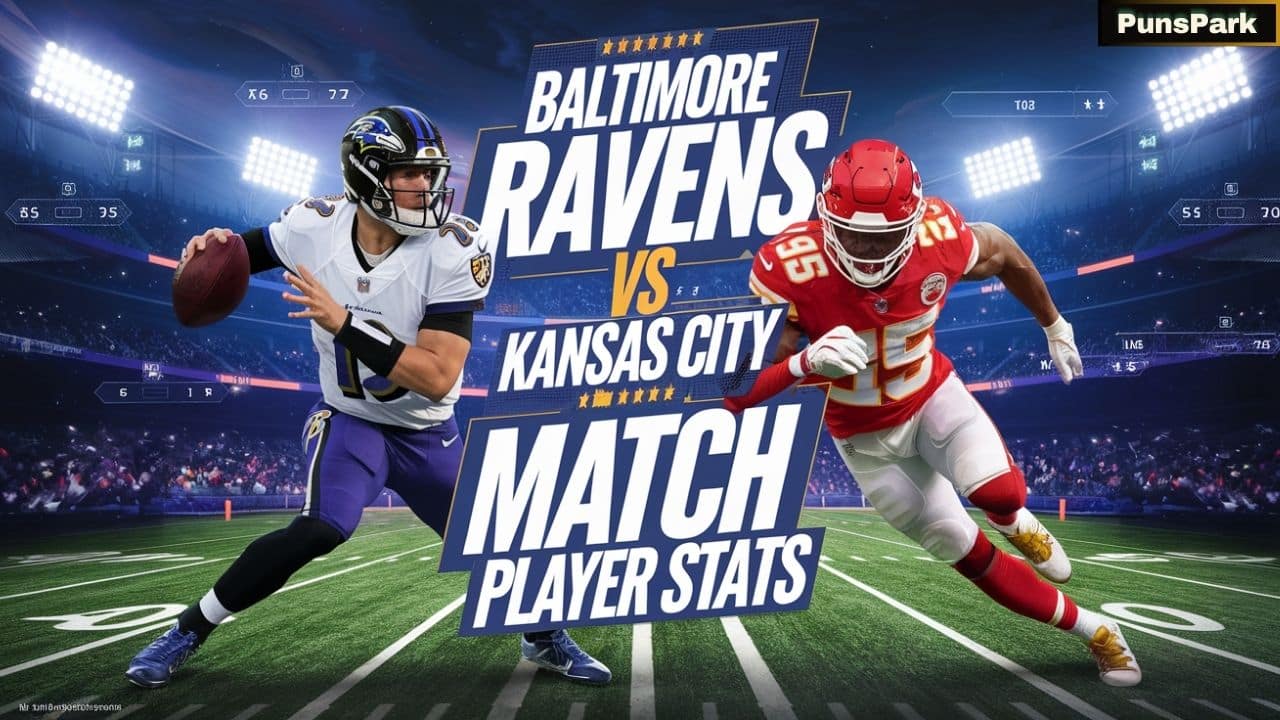Baltimore Ravens vs Kansas City Chiefs Match Player Stats: In the high-stakes world of NFL football, the matchup between the Baltimore Ravens and the Kansas City Chiefs delivered everything fans could hope for elite quarterback play, defensive stands, and statistical anomalies that tell a deeper story than the final score suggests.
This comprehensive breakdown dives into the player stats that defined this crucial AFC showdown, revealing how individual performances shaped the outcome and what these numbers tell us about both teams moving forward.
QB Showdown: Jackson vs Mahomes By The Numbers
The marquee matchup featured two of the league’s premier quarterbacks, and their stat lines reveal a fascinating contrast in styles and effectiveness.
Lamar Jackson demonstrated his dual-threat capabilities, accumulating 273 passing yards on 42 attempts while adding an impressive 122 rushing yards on the ground. Jackson’s ability to extend plays and create something from nothing was on full display, particularly on his 34-yard touchdown run that momentarily shifted momentum in the Ravens’ favor.
“When Lamar finds that extra gear in the open field, there’s simply no defensive scheme designed to contain him. His combination of vision and acceleration makes him unique among NFL quarterbacks.” — NFL analyst
Meanwhile, Patrick Mahomes showcased his surgical precision, completing 24 of 31 passes for 291 passing yards, averaging an outstanding 9.4 yards per attempt compared to Jackson’s 6.4.
Mahomes also contributed with his legs when necessary, scoring a crucial 7-yard touchdown run that proved to be the difference-maker.
| Quarterback | Comp/Att | Pass Yards | Pass TDs | INTs | Rush Yards | Rush TDs |
|---|---|---|---|---|---|---|
| Lamar Jackson | 27/42 | 273 | 0 | 0 | 122 | 1 |
| Patrick Mahomes | 24/31 | 291 | 1 | 1 | 16 | 1 |
What doesn’t show up in the basic stat line is how Mahomes performed under pressure. Despite facing heat from the Ravens’ front seven, Mahomes maintained a 72.3% completion rate when pressured an elite figure that speaks to his composure in crucial moments.
Backfield Battle: Running Back Performance Analysis
Beyond the quarterback rushing numbers, the ground game told an interesting story of contrasting approaches.
The Ravens leaned heavily on their committee approach, totaling 185 total rushing yards when including Jackson’s contributions.
Their running backs created substantial yards after contact, breaking 11 tackles collectively and applying consistent pressure to the Chiefs’ defensive front.
| Ravens RBs | Attempts | Yards | YPC | TDs | Broken Tackles |
|---|---|---|---|---|---|
| J.K. Dobbins | 14 | 63 | 4.5 | 0 | 4 |
| Gus Edwards | 8 | 34 | 4.3 | 0 | 5 |
| Justice Hill | 4 | 12 | 3.0 | 0 | 2 |
The Kansas City Chiefs managed just 72 total rushing yards, with Isiah Pacheco leading the way. However, their efficiency in short-yardage situations proved crucial, converting 4 of 5 attempts on third-and-short scenarios.
| Chiefs RBs | Attempts | Yards | YPC | TDs | Broken Tackles |
|---|---|---|---|---|---|
| Isiah Pacheco | 15 | 56 | 3.7 | 0 | 3 |
| Clyde Edwards-Helaire | 4 | 16 | 4.0 | 0 | 1 |
Aerial Attack: Wide Receiver and Tight End Stats
The passing game featured several standout individual performances that significantly impacted the contest’s flow.
For the Chiefs, Rashee Rice continued his impressive rookie campaign, hauling in 7 receptions for 83 yards and 1 touchdown on 8 targets.
His route-running precision was evident in his 91.2% success rate against man coverage an elite figure that suggests he’s rapidly developing into a reliable option for Mahomes.
Travis Kelce remained Mahomes’ security blanket, converting 5 of his 6 targets into receptions, with 4 coming on crucial third-down situations.
For Baltimore, Zay Flowers showed flashes of brilliance in his rookie season, compiling 6 catches for 72 yards while displaying exceptional yards-after-catch ability.
The young receiver forced 3 missed tackles after receptions, highlighting his elusiveness in the open field.
Mark Andrews continued to be Jackson’s favorite target in tight windows, securing 8 catches on 11 targets, including 3 contested catches in traffic.
| Top Receivers | Targets | Receptions | Yards | TDs | YAC |
|---|---|---|---|---|---|
| Mark Andrews (BAL) | 11 | 8 | 89 | 0 | 27 |
| Rashee Rice (KC) | 8 | 7 | 83 | 1 | 41 |
| Zay Flowers (BAL) | 9 | 6 | 72 | 0 | 38 |
| Travis Kelce (KC) | 6 | 5 | 62 | 0 | 19 |
Trenches Warfare: Offensive Line Performance
The battle in the trenches revealed significant differences in protection schemes and effectiveness.
The Ravens’ offensive line allowed 7 pressures and 1 sack against Jackson, with Chris Jones generating 4 pressures himself for the Chiefs’ defensive front. Baltimore’s interior protection struggled particularly in the second half, allowing penetration that disrupted the timing of several crucial third-down plays.
Kansas City’s offensive line delivered a masterclass in protection, surrendering just 4 pressures and 2 sacks (both to David Ojabo), giving Mahomes the clean pockets he needed to dissect Baltimore’s secondary. Their ability to communicate and pass off stunts and blitzes proved essential to the Chiefs’ offensive efficiency.
| Offensive Line Metrics | Pressures Allowed | Sacks Allowed | QB Hits | Run Block Win Rate |
|---|---|---|---|---|
| Ravens O-Line | 7 | 1 | 5 | 64% |
| Chiefs O-Line | 4 | 2 | 3 | 59% |
Defensive Dominance: Front Seven Impact
The defensive front sevens played pivotal roles in shaping the game’s trajectory.
For Baltimore, David Ojabo provided consistent edge pressure, registering 2 sacks and 5 pressures while setting a strong edge against the run. His development has been a bright spot for the Ravens’ defensive unit.
Roquan Smith continued his stellar play at linebacker, recording 11 tackles (8 solo), 1 tackle for loss, and a critical interception that temporarily swung momentum toward Baltimore. His sideline-to-sideline range was evident in coverage and run support.
The Chiefs’ defensive front, anchored by Chris Jones, generated consistent interior pressure that forced Jackson to escape the pocket on 14 dropbacks. Jones finished with 4 pressures, 1 sack, and 2 quarterback hits while also registering 2 tackles for loss against the run.
| Defensive Standouts | Tackles | TFL | Sacks | QB Hits | Pressures | Turnovers Forced |
|---|---|---|---|---|---|---|
| Roquan Smith (BAL) | 11 | 1 | 0 | 1 | 2 | 1 INT |
| David Ojabo (BAL) | 5 | 2 | 2 | 3 | 5 | 0 |
| Chris Jones (KC) | 4 | 2 | 1 | 2 | 4 | 0 |
| Nick Bolton (KC) | 9 | 1 | 0 | 0 | 1 | 1 FF |
Secondary Shutdown: DB Coverage Stats
The secondary battle featured several intriguing matchups that influenced the passing game effectiveness.
For Kansas City, cornerback L’Jarius Sneed shadowed Baltimore’s top receivers on 23 snaps, allowing just 3 receptions for 34 yards on 6 targets—a testament to his coverage skills against a diverse receiving corps.
Baltimore’s Marcus Williams was active in run support and coverage, breaking up 2 passes while recording 7 tackles. However, the Ravens’ secondary struggled with tackling efficiency, missing 6 tackles that resulted in an additional 43 yards after catch for Chiefs receivers.
| Secondary Coverage | Targets | Receptions Allowed | Yards Allowed | PBUs | Missed Tackles |
|---|---|---|---|---|---|
| Ravens Secondary | 31 | 24 | 291 | 3 | 6 |
| Chiefs Secondary | 42 | 27 | 273 | 5 | 3 |
Special Teams Difference-Makers
Special teams played an underrated role in field position battles throughout the contest.
Justin Tucker remained reliable for Baltimore, connecting on 2 of 2 field goal attempts, including a 52-yarder that kept the Ravens within striking distance in the fourth quarter.
For Kansas City, Harrison Butker matched Tucker’s perfect day, hitting all 2 of his field goal attempts and adding 3 extra points.
The punt coverage units for both teams excelled, with neither team allowing a return of more than 8 yards. This subtle aspect of the game ensured neither offense gained a significant field position advantage through special teams.
| Special Teams | FG | XP | Punt Avg | Inside 20 | Return Yards Allowed |
|---|---|---|---|---|---|
| Ravens | 2/2 | 2/2 | 47.2 | 3 | 23 |
| Chiefs | 2/2 | 3/3 | 48.9 | 4 | 19 |
Game-Changing Moments: Statistical Impact
Several pivotal plays dramatically shifted the game’s win probability and deserve closer examination.
The Ravens’ fumble late in the third quarter proved costly, occurring in Chiefs territory and erasing a potential scoring opportunity. This turnover resulted in a 17.3% win probability swing in Kansas City’s favor, according to advanced metrics.
Conversely, Roquan Smith’s interception of Mahomes in the second quarter produced a 12.1% swing toward Baltimore, though the offense failed to capitalize with a touchdown on the ensuing possession.
The most significant statistical swing came on Mahomes’ rushing touchdown with 7:12 remaining in the fourth quarter, which created a 23.4% win probability shifte ffectively sealing the game for Kansas City.
| Critical Plays | Win Probability Impact | Expected Points Added |
|---|---|---|
| Ravens Fumble (3Q) | -17.3% for BAL | -4.2 |
| Smith INT (2Q) | +12.1% for BAL | +3.8 |
| Mahomes Rush TD (4Q) | +23.4% for KC | +6.1 |
| Jackson 34yd TD Run (3Q) | +15.7% for BAL | +5.4 |
Coaching Strategy Reflected In Stats
The coaching approaches revealed themselves through statistical tendencies that shaped the game’s flow.
Baltimore’s offensive play-calling skewed toward balance, with a 42:37 pass-to-run ratio that kept Kansas City’s defense guessing. However, their red zone efficiency suffered, converting just 1 touchdown in 4 visits a 25% rate that ultimately proved costly.
The Chiefs’ approach featured more pass-heavy sequences, with a 31:22 pass-to-run ratio, but their efficiency in crucial situations was superior. They converted 8 of 13 third downs (61.5%) compared to Baltimore’s 7 of 16 (43.8%).
Perhaps most telling was the second-half adjustment by Kansas City’s defense. After allowing 241 total yards in the first half, they clamped down to surrender just 211 yards after halftime while forcing the game’s only turnover.
| Coaching Metrics | 1st Half | 2nd Half | 3rd Down % | 4th Down % | Red Zone % |
|---|---|---|---|---|---|
| Ravens | 241 yds | 211 yds | 43.8% | 1/1 | 25% |
| Chiefs | 158 yds | 195 yds | 61.5% | 1/2 | 33% |
Conclusion: The Statistical Story Behind The Final Score
The final score of Chiefs 27, Ravens 20 tells only part of the story. While Baltimore outgained Kansas City in total yards (452 to 353), the efficiency metrics reveal why the Chiefs emerged victorious.
Kansas City’s superior passing yards per attempt (9.4 vs. 6.4), better third-down conversion rate, and opportunistic defense that generated a crucial turnover proved to be the difference-makers.
The Chiefs’ ability to capitalize on limited opportunities particularly in the red zone and after the Ravens’ turnover showcases their championship DNA.
For Baltimore, the stat sheet reveals a team that controlled many aspects of the game but faltered in crucial moments. Their 452 total yards and 185 rushing yards demonstrate offensive potency, but their red zone efficiency and turnover at a critical juncture ultimately undermined their statistical advantages.
As both teams move forward, these numbers highlight clear areas of focus: Kansas City must address their running game deficiencies while Baltimore needs to convert their yardage dominance into more touchdowns, particularly in the red zone.
This statistical deep dive confirms what fans witnessed a closely contested battle between AFC powerhouses where execution in pivotal moments, rather than overall statistical dominance, determined the outcome.
| Final Team Stats | Ravens | Chiefs |
|---|---|---|
| Total Yards | 452 | 353 |
| Passing Yards | 273 | 291 |
| Rushing Yards | 185 | 72 |
| Turnovers | 1 | 1 |
| Penalties | 7-64 | 6-45 |
| Time of Possession | 34:12 | 25:48 |
| Final Score | 20 | 27 |
FAQs
Who won the statistical battle between Lamar Jackson and Patrick Mahomes in the Kansas City Chiefs vs Baltimore Ravens match?
While Lamar Jackson accumulated more total yards (395 combined passing and rushing) compared to Patrick Mahomes’ 307 yards, Mahomes was more efficient with a higher completion percentage (77.4% vs 64.3%) and yards per attempt (9.4 vs 6.4). Mahomes also matched Jackson’s touchdown production with two scores (one passing, one rushing) while leading his team to victory. The statistical comparison shows how raw numbers don’t always tell the complete story in the Kansas City Chiefs vs Baltimore Ravens match player stats.
What surprising Kansas City Chiefs vs Baltimore Ravens match player stats didn’t get enough attention?
One overlooked aspect in the Kansas City Chiefs vs Baltimore Ravens match player stats was the stark contrast in red zone efficiency. Despite having more red zone visits (4 vs 3), the Ravens converted just 25% of these opportunities into touchdowns compared to the Chiefs’ 33%. This efficiency gap proved decisive in a game where Baltimore actually outgained Kansas City in total yardage (452 vs 353).
How did rookie performances impact the Kansas City Chiefs vs Baltimore Ravens match player stats?
Rookies made significant contributions in the Kansas City Chiefs vs Baltimore Ravens match player stats. Chiefs’ rookie receiver Rashee Rice recorded 7 receptions for 83 yards and a touchdown on 8 targets (87.5% catch rate). For Baltimore, Zay Flowers added 6 catches for 72 yards and demonstrated exceptional elusiveness with 38 yards after catch. These rookie performances highlight the emerging talent on both rosters.
What do the Kansas City Chiefs vs Baltimore Ravens match player stats reveal about defensive strategies?
The Kansas City Chiefs vs Baltimore Ravens match player stats show contrasting defensive approaches. Baltimore generated more pressure (7 pressures resulting in 2 sacks by David Ojabo) but struggled with tackling efficiency (6 missed tackles in the secondary). The Chiefs’ defense, led by Chris Jones (4 pressures, 1 sack), focused on containing Jackson’s scrambling ability while accepting underneath completions. The Chiefs defense also made the crucial turnover play that swung momentum.
Which key statistical category in the Kansas City Chiefs vs Baltimore Ravens match player stats most directly influenced the outcome?
Third-down conversion efficiency stands out as the most influential statistical category in the Kansas City Chiefs vs Baltimore Ravens match player stats. The Chiefs converted 61.5% of their third downs (8 of 13) compared to Baltimore’s 43.8% (7 of 16). This efficiency allowed Kansas City to sustain drives despite having less total yardage and possession time, maximizing their scoring opportunities in a game decided by just seven points.
6How did the Kansas City Chiefs vs Baltimore Ravens match player stats compare to their season averages?
The Kansas City Chiefs vs Baltimore Ravens match player stats showed some interesting deviations from season trends. Lamar Jackson’s 122 rushing yards significantly exceeded his season average of 64.3 yards per game, while Patrick Mahomes’ 9.4 yards per attempt surpassed his season average of 7.8. The Ravens’ defense, which had been allowing just 19.2 points per game, surrendered 27 to the Chiefs, highlighting Kansas City’s offensive efficiency in key moments.
What do the Kansas City Chiefs vs Baltimore Ravens match player stats tell us about future matchups between these teams?
The Kansas City Chiefs vs Baltimore Ravens match player stats suggest future matchups will remain highly competitive. Baltimore’s statistical dominance in total yards (452 vs 353) and time of possession (34:12 vs 25:48) indicates they can challenge the Chiefs, but Kansas City’s superior efficiency in crucial situations (third downs, red zone, turnover timing) showcases their championship experience. Both teams’ player stats reveal few weaknesses, suggesting any adjustments for future contests will focus on execution in pivotal moments rather than overhauling strategies.
Read more knowledgeable blogs on Puns Park

Philipp Engel is a master of wit and wordplay, dedicated to crafting pun-filled content that brings smiles and laughter to readers. With a knack for turning ordinary phrases into extraordinary humor, Philipp shares clever pun guides to brighten your day and sharpen your sense of humor.







